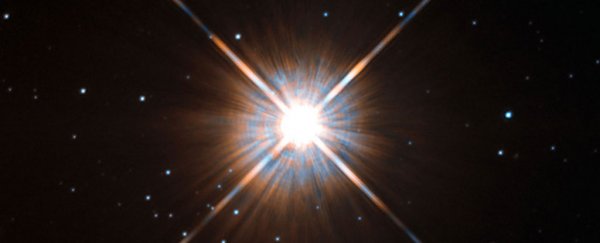The nearest star system to our own could hold our best chance of finding a habitable, Earth-like exoplanet – but it may also be concealing a dark, long-kept secret.
Alpha Centauri, located just 4.37 light-years from our own Solar System, is the closest thing we have to a neighbour in the galaxy, but it looks like one of its three stars could be a victim of theft on an interstellar scale.
According to new research, Proxima Centauri – the host of the much-hyped Proxima b, which scientists think could be our closest habitable exoplanet – didn't originate beside its stellar companions, Alpha Centauri A and Alpha Centauri B.
While the potential habitability of Proxima b is a hotly debated topic in astronomy and astrophysics, what could be even more remarkable is that this alien world didn't always hang so close to our own Solar System.
New calculations run by researchers at the University of Hertfordshire in the UK suggest that the Alpha Centauri system may have once only contained two stars – Alpha Centauri A and B – which gravitationally intercepted a third in Proxima Centauri.
Running simulations of the three stars' orbits over an epic 10-billion year time frame, the team found the orbit of Proxima Centauri was only bound to Alpha Centauri A and B in 74 percent of cases.
"If the three stars have been orbiting each other for a few billion years, one would think they'd be a nice happy family," astrophysicist Scott Kenyon from the Harvard-Smithsonian Centre for Astrophysics, who wasn't involved with the study, told New Scientist.
In other circumstances – simulations of the star's orbit called 'clones' – the star became unbound from its companions: an instability the researchers think is most unusual if the stars had all been born in the same system.
In some of the modelling, this instability even became more apparent.
"If the system migrated outward in the Milky Way to its current location, more than 50 percent of clones could become unstable in backward simulations," the authors write in their paper.
"The ratio of unstable clones increases with the simulation time scale and encounter rate."
All told, the team thinks there's a 25 percent chance that Proxima Centauri – and its host planet, Proxima b – were captured in the gravitational embrace of Alpha Centauri A and B at some point in galactic history, unknown aeons ago.
Of course, it's only a one-in-four hypothetical possibility based on simulations at this point, but if this capture scenario is what actually happened in Proxima Centauri's distant past, it could potentially boost the prospects of finding life on Proxima b, the team thinks.
That's because, in its current stellar environment, there's evidence to suggest Proxima b might be incapable of hosting life, but the researchers think if Proxima Centauri's union with Alpha Centauri A and B is a more recent phenomenon, then the chances for life on it are stronger.
"Life needs time to develop and emerge," one of the researchers, Fabo Feng, told New Scientist.
"This scenario gives it more time."
The findings are reported in Monthly Notices of the Royal Astronomical Society.
